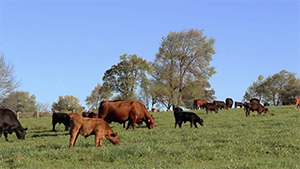Plan to Adapt When Grazing

Adaptive grazing herd management applies to grazing practices that are developed with careful consideration to the specific conditions that exist on individual farms and ranches. When it comes to adaptive grazing management, it’s all about using the resources you have available and incorporating different techniques depending on where you live, says rancher and consultant Sean McGrath. McGrath spoke about the value of being flexible but also the importance of making a plan and measuring success, during a BCRC webinar last winter.
Managing the movement of cattle through pastures or paddocks will help producers achieve energy efficiency. “Plants are solar panels and to make them efficient, we need to make sure there are solar panels there to start with,” McGrath said. He pointed out that it is much cheaper for cattle to graze than it is to manually feed them and understanding the key principles of grazing management is vital for adaptive management (skip ahead to 15:05).
Producers should manage herd movement to prevent overgrazing, which is defined as a plant being grazed before it has recovered from the previous grazing event. “We would never cut a hay field on the first of June and come back and hay it on June 10. A pasture is no different,” McGrath reasoned.
Forage yield ultimately drives costs (go to 16:36). McGrath stressed that it is important to monitor and measure your system to determine if you are meeting your goals. This gets easier with time and experience. On his operation, McGrath keeps track of his productivity by measuring the amount of Animal Unit Grazing Days (AUGD) his herd gets out of a particular pasture. One AUGD is the amount of forage consumed by a 1000lb cow in one day. If that cow is 1500 lb, you would use a conversion factor of 1.5, or if a heifer is 500 lb, you use an adjusted factor of 0.5 (go to an example from the webinar).
Another parameter of adaptive grazing management is matching the forage to the cow’s nutritional requirements (skip to 19:09). The energy and protein requirements of a cow are lowest during her second trimester so producers can make the most out of their lowest quality forage at that time. Her requirements peak during the rebreeding period when she needs the highest quality forage available. Producers should ask themselves if they need to supplement their cows, plan their calving to match the forage quantity and quality, or preserve forage quality by cutting it for swath-grazing or baling.
Producers don’t necessarily need to follow a set grazing rotation or pattern. “You want to move to the paddock that’s in the best condition with the most recovery,” McGrath explained. In order to manage grazing, ranchers may want to consider setting up electric fencing (go to 24:02). McGrath pointed out that electric fencing is much cheaper and requires less labour than other options but acknowledged that there can be self-imposed challenges. “If you think it works, it does. If you think it doesn’t, it won’t,” he said, but added that as long as it’s set up correctly with plenty of ground rods, it is a good option. Where terrain isn’t conducive to fencing, working with the natural landscape features can be an effective way of guiding animal movement (for real-life scenarios, skip to 27:08
“If you think it works, it does. If you think it doesn’t, it won’t.”
Sean McGrath
Producers looking for a way to start improving grazing management should consider combining herds. Many farms already have a lot of paddocks fenced out but run several smaller herds. Combining those cow herds will allow more paddocks time to recover and allow producers to monitor their cattle more closely. Salt and mineral placement can also be used to help control animal movement, as can moving around feed, supplements, or even water troughs. McGrath noted that farmers can achieve some adaptive practices and improve their forage bases without investing in a lot of additional infrastructure.
Part of being adaptable is preparing for drought (go to 38:39). “Drought planning needs to start when it’s raining. It’s easier to plan ahead when you have resources in place than trying to react,” McGrath recommended. Paying attention to litter, the dead plant residue left remaining after grazing, can be useful when determining management adjustments. He described litter as the moisture-storing security blanket that will help start pasture plants and get them to the 3-5 leaf stage (Phase 2) when they can drive plants roots deep into the ground. McGrath explained that it may be better to feed for a couple of weeks in May in order to let those plants have a good start. If dry conditions persist, McGrath suggested having a marketing plan in place for reducing your herd size. For example, plan to sell open cows first, then other animals as needed, including yearlings or cattle needing to be culled due to temperament or productivity issues.“As beef producers, we are in the business of capturing sunlight and water,” McGrath concluded. By focusing on energy efficiency and adapting practices to suit the environment and the cow herd, producers let cows do what they do best – graze.
Learn More:
- Drought Management Strategies (BCRC webpage)
- Grazing Management (BCRC webpage)
- Rangeland and Riparian Health (BCRC webpage)
Click here to subscribe to the BCRC Blog and receive email notifications when new content is posted.
The sharing or reprinting of BCRC Blog articles is welcome and encouraged. Please provide acknowledgement to the Beef Cattle Research Council, list the website address, www.BeefResearch.ca, and let us know you chose to share the article by emailing us at [email protected].
We welcome your questions, comments and suggestions. Contact us directly or generate public discussion by posting your thoughts below.
